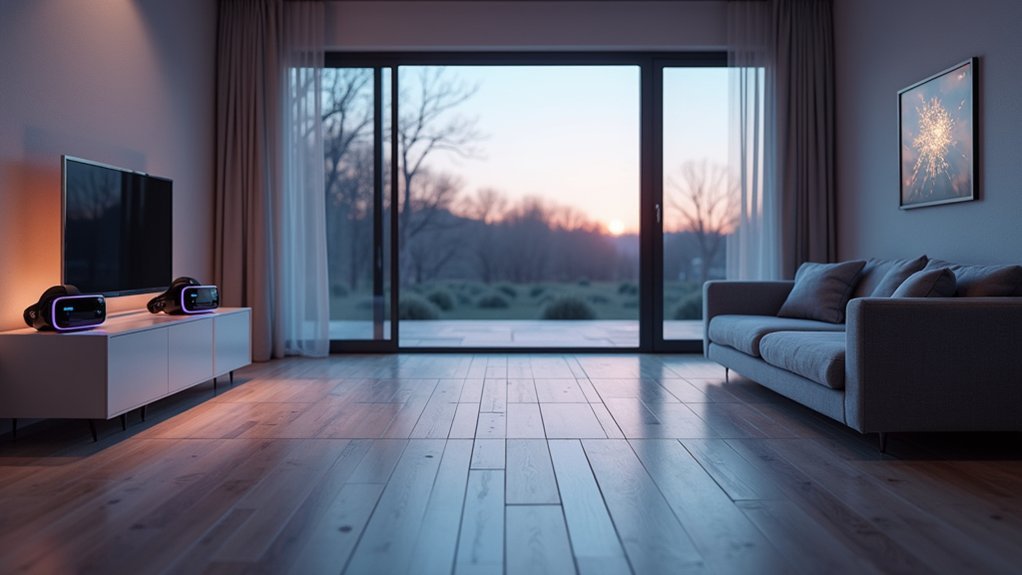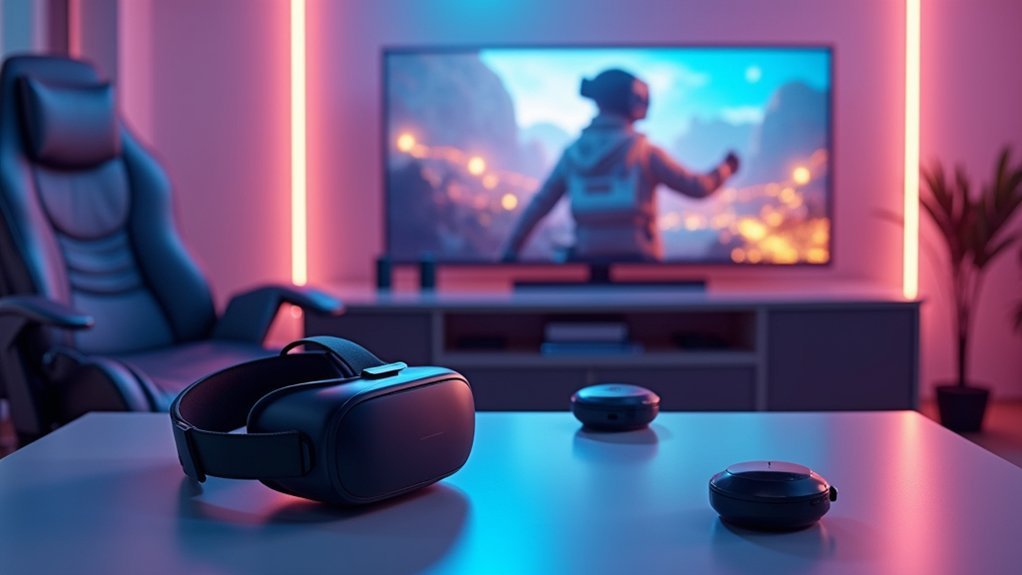You’ll need a minimum 1.5 × 1.5 meter clear space with strategically positioned sensors in opposite corners for maximum coverage. Secure cables along walls using clips, make sure your VR headset’s fully charged, and maintain 25 Mbps internet speed with 5 GHz Wi-Fi for best performance. Install interlocking foam tiles for cushioning, establish clear boundaries free of obstacles, and regularly calibrate your system after equipment repositioning. These fundamentals create the foundation for exploring advanced wireless VR optimization techniques.
Minimum Space Requirements for Wireless VR Movement

You’ll need at least 1.5 × 1.5 meters of clear floor space to safely enjoy wireless VR movement. This minimum space requirement guarantees you can interact effectively within your virtual environment without safety concerns.
Your play area must remain completely free of obstacles to allow full movement of arms and legs during gameplay.
Clear your VR space of all furniture, decorations, and obstacles to ensure unrestricted arm and leg movement during immersive gameplay sessions.
For best setup essentials, position two diagonal sensors across your room to maximize tracking accuracy and create smoother wireless VR experiences. These sensors enable more fluid movement throughout your sessions.
Establish clear boundaries during initial setup to define safe gameplay zones and prevent accidental exits from your designated area.
You’ll want to regularly inspect your space for new obstacles or hazards that could compromise your wireless VR safety.
Strategic Sensor Positioning for Optimal Tracking Coverage
You’ll achieve maximum tracking coverage by positioning your sensors diagonally across opposite corners of your play space.
This corner placement creates overlapping detection zones that eliminate blind spots while providing 360-degree movement freedom.
Mount each sensor above head height and angle them slightly downward to capture your full range of motion without interference from furniture or body occlusion.
Diagonal Corner Placement Strategy
One key positioning strategy transforms your room-scale VR experience: placing sensors diagonally across opposite corners of your play area. This diagonal placement maximizes tracking coverage by expanding each sensor’s field of view, enabling full movement within a 1.5 × 1.5 meter space without losing precision.
| Corner Position | Height Range | Coverage Angle |
|---|---|---|
| Front Left | 2-2.5m | 120° downward |
| Back Right | 2-2.5m | 120° downward |
| Front Right | 1.8-2.3m | 110° downward |
| Back Left | 1.8-2.3m | 110° downward |
| Ceiling Mount | 2.5-3m | 130° downward |
Mount sensors elevated and unobstructed to prevent furniture interference. This configuration creates an immersive experience, allowing natural interaction with your virtual environment. Regularly check sensor angles and heights when relocating your setup to maintain ideal tracking performance throughout your gaming sessions.
Tracking Zone Coverage
When positioning sensors for wireless room-scale VR, achieving extensive tracking zone coverage requires strategic placement that eliminates dead zones while maintaining consistent signal strength.
Your wireless setup’s performance depends on maximizing detection range while minimizing blind spots throughout the play area.
Here’s how to optimize your tracking zone:
- Position sensors diagonally across opposite corners to create overlapping coverage fields that capture motion tracking from multiple angles.
- Maintain 2-4 meter distance between sensors to establish an ideal tracking zone without compromising individual sensor performance.
- Angle sensors toward the center of your play area to guarantee accurate motion detection during active gameplay sessions.
- Recalibrate after repositioning to uphold consistent tracking accuracy and account for environmental changes.
Proper sensor placement transforms your space into a seamless VR environment with reliable tracking coverage.
Height and Angle Optimization
Strategic height placement dramatically impacts your wireless VR tracking performance, with sensors mounted at 2.1 meters (7 feet) providing the ideal vantage point for thorough coverage.
This elevation guarantees clear line-of-sight with your headset and controllers throughout your play area.
Angle your sensors downward at approximately 30 degrees to capture movements more effectively.
This downward tilt optimizes tracking by focusing on the space where you’ll actually be moving, rather than walls or ceiling areas that don’t require monitoring.
Proper height and angle optimization prevents common tracking issues that occur when sensors can’t consistently monitor your movements.
Avoid positioning sensors near obstacles that could block their view or create interference.
Regular adjustments to sensor positioning maintains peak performance as your gameplay patterns evolve.
Cable Management Solutions to Prevent Tripping Hazards
Even in wireless room-scale VR setups, you’ll still encounter cables from power adapters, charging stations, and base stations that can create dangerous tripping hazards.
You can minimize these risks through wireless adapters that eliminate headset cables, smart routing techniques that guide remaining wires away from your play space, and protective flooring solutions that cushion falls while alerting you to cable locations.
Managing these cables properly transforms your VR environment from a potential accident zone into a safe, immersive playground.
Wireless Adapter Benefits
Freedom of movement transforms your VR experience when you eliminate the cable tether that connects your headset to your PC.
Wireless adapters revolutionize room-scale VR by removing physical constraints that limit your immersive experience.
Here are four key benefits you’ll gain:
- Enhanced Safety – You’ll eliminate tripping hazards completely, creating a safer play area for intense gaming sessions.
- Unrestricted Movement – Your freedom of movement increases dramatically without cable limitations holding you back.
- Responsive Performance – Low-latency technology guarantees your gameplay remains smooth and responsive throughout sessions.
- Simplified Installation – The setup process becomes straightforward without complex cable management requirements.
Wireless solutions often include helpful accessories like clips and straps to keep your space organized, further reducing potential hazards while maximizing your VR potential.
Cable Routing Techniques
While wireless adapters offer the ultimate freedom, proper cable routing remains essential for wired VR setups and hybrid configurations. Effective cable management prevents tripping hazards that could disrupt your immersive experience.
Use cable clips or adhesive sleeves to secure cables along walls and furniture, keeping them off the floor in your VR play area. Opt for flat cables that route easily under carpets, reducing visibility and snag points.
A cable raceway system helps neatly contain cables along baseboards, ensuring safe movement during gameplay. Install a wireless charging station for controllers to eliminate charging cables that create clutter.
Don’t forget to regularly inspect cable placements, adjusting them as needed to maintain clear walking paths and enhance safety throughout your gaming sessions.
Floor Protection Methods
Beyond securing cables to walls and baseboards, protecting your floor space requires strategic solutions that address both safety and comfort.
Your play area needs thoughtful floor protection methods that enhance wireless options while managing remaining cables.
- Install interlocking foam tiles that provide cushioning and help visually delineate your safe gameplay area from cable routes.
- Place floor mats strategically to create defined boundaries between your movement zone and potential hazards.
- Bundle loose cables with Velcro straps, keeping them organized and away from high-traffic areas.
- Regularly inspect your setup, adjusting cable management solutions as needed to maintain an unobstructed environment.
These floor protection methods offer comfort and caution, creating a secure foundation for immersive VR experiences while minimizing tripping risks.
Power Source Planning for Uninterrupted Gameplay Sessions
Since wireless VR headsets rely entirely on battery power, you’ll need a strategic approach to power management that keeps your gaming sessions flowing without interruption.
Start by ensuring your VR headset’s fully charged before each session to maximize uninterrupted gameplay time. Set up a dedicated power outlet exclusively for your VR equipment, preventing circuit overloads and maintaining stable power supply.
Consider investing in a wireless charging station or battery pack for seamless mobility without tangled cords during intense sessions.
When charging controllers and other devices, plan your play area layout for easy power source access while maintaining a clean environment.
Regularly inspect all power cables and connections to prevent disruptions, ensuring every component functions properly for smooth VR experience throughout extended gameplay sessions.
System Calibration for Precise Motion Detection

After establishing your power management strategy, you’ll need to focus on precise system calibration to achieve accurate motion detection throughout your wireless VR experience.
Proper system calibration guarantees your tracking devices maintain ideal tracking precision by establishing clear sensor alignment and maintaining a clear line of sight between components.
Follow these essential calibration steps:
- Initial Setup – Check sensor alignment and verify tracking devices have unobstructed visibility according to manufacturer guidelines.
- Floor Calibration – Maintain consistent headset height and adjust floor position settings to match your actual physical floor level.
- Play Area Boundary – Establish obstacle-free boundaries to prevent interference that compromises tracking performance.
- Regular Maintenance – Keep recalibrating after relocating equipment or moving furniture, utilizing platform tools like SteamVR to enhance your gameplay experience.
Safety Boundary Setup and Floor Preparation
While accurate tracking forms the foundation of wireless VR, your physical safety depends entirely on establishing proper boundaries and preparing your floor space.
Start by removing all obstacles, including furniture and pets, from your designated play area. You’ll need minimum space of 1.5 × 1.5 meters for full arm and leg movement. Trace along the floor to create your defined area, ensuring you maintain a clear boundary from walls and objects.
Consider installing tactile flooring like interlocking foam squares to provide physical feedback when you’re approaching limits. These materials help prevent accidental collisions while indicating safe gameplay zones.
Remember to regularly check your setup for new environmental hazards, as changes can introduce unexpected risks during intense gameplay sessions.
Network Requirements for Stable Wireless Performance

Your wireless VR experience hinges on a robust network foundation that can handle the demanding data streams required for seamless gameplay.
A solid network infrastructure is the backbone of uninterrupted wireless VR gaming and immersive virtual experiences.
A stable wireless network demands specific technical requirements to prevent wireless interruptions and maintain peak performance.
Here’s what you need for reliable wireless VR:
- Internet Speed: Secure minimum internet speed of 5 Mbps, though 25 Mbps delivers peak performance for demanding VR applications.
- Router Configuration: Use 5 GHz Wi-Fi bands and verify your router supports modern Wi-Fi standards like Wi-Fi 5 or Wi-Fi 6 for enhanced connectivity.
- Router Position: Place your router close to your play area to maximize signal strength and minimize latency during gameplay.
- Wired Backup: Consider an ethernet connection for your VR computer to eliminate potential wireless connectivity issues entirely.
Frequently Asked Questions
Can I Use My Wireless VR Setup Outdoors or in Sunlit Rooms?
You shouldn’t use wireless VR outdoors or in direct sunlight. Bright light interferes with tracking sensors and can damage your headset’s screens. You’ll get poor performance and risk permanent hardware damage from overheating.
How Often Should I Clean My VR Headset Lenses for Optimal Performance?
You should clean your VR headset lenses after every few gaming sessions or when you notice smudges affecting clarity. Use microfiber cloths and lens cleaning solutions designed specifically for delicate optical surfaces.
What Happens if My Internet Connection Drops During Wireless Gameplay?
Your wireless VR gameplay will immediately pause or disconnect when internet drops. You’ll lose multiplayer sessions and cloud features, but single-player games stored locally might continue running depending on your headset’s offline capabilities.
Are There Specific Flooring Materials That Work Better for Room-Scale VR?
You’ll find carpet provides excellent cushioning for falls but can cause tracking issues. Hard surfaces like hardwood or tile offer better tracking accuracy. Avoid reflective materials that interfere with sensors and guarantee adequate grip.
Can Multiple People Use the Same Wireless VR Setup Simultaneously?
You can’t have multiple people simultaneously using the same wireless VR headset since it’s designed for one user. However, you can take turns or use multiple headsets for shared experiences.
In Summary
You’ve got everything you need to create an immersive wireless VR experience. Don’t rush the setup process—take time to properly position your sensors, clear your play area, and test your boundaries. Remember that a well-prepared room prevents accidents and enhances gameplay. Double-check your network stability and power sources before diving into extended gaming sessions. With these essentials in place, you’ll enjoy seamless, untethered virtual reality adventures.





Leave a Reply